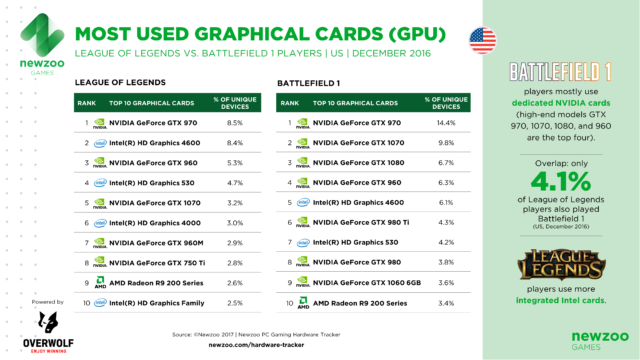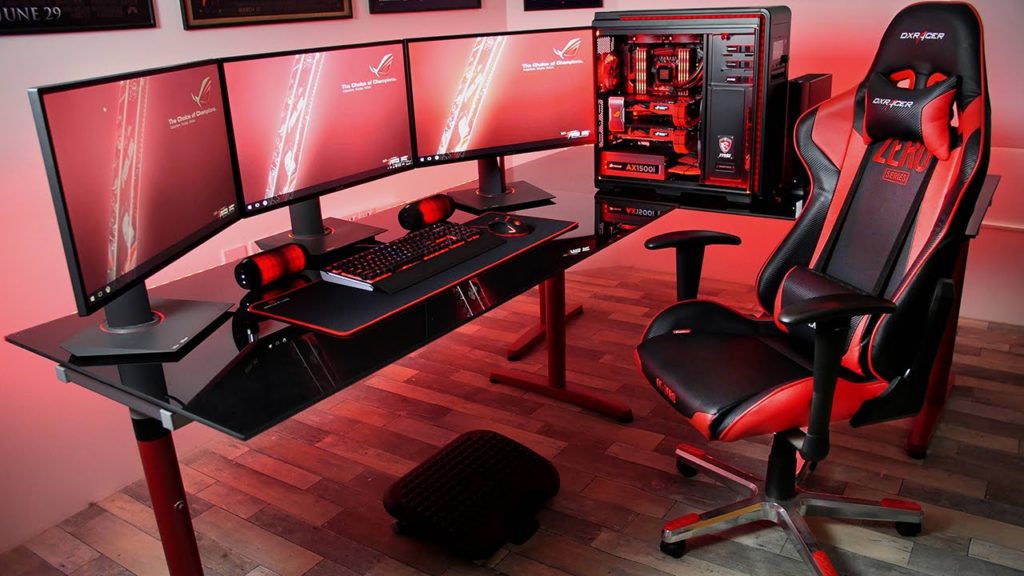PC gamers have traditionally been a market unto themselves—hardcore, rig-building fans ready to tackle the most graphically intensive games on the market. While stereotypical hardcore PC gamers do exist in all their overclocked glory, data gathered by Newzoo reveals a parallel group of PC gamers who play less visually intensive—yet more competitive—games online, calling to question previous assumptions about the demographic as a whole.
Using its PC Gaming Hardware Tracker, Newzoo examined the specifications of computers used by millions of US game enthusiasts for two popular PC games—League of Legends (LoL) and Battlefield 1. Both games are competitive, highly popular and played on a PC—and yet when it comes to hardware, these titles only had a four percent audience overlap. While Battlefield 1 requires a more expensive kit to run its near photo-realistic graphics across 64-person multiplayer, League of Legends does not, allowing it to reach a wider audience and increase its portability.
“This is particularly essential for games used in eSports,” Newzoo noted in its findings, “where a low barrier of entry and a higher level of device portability are required to allow teams of players to travel, train and compete together.”

Peter Warman, CEO of Newzoo, told [a]listdaily that marketing a PC video game is no longer just about the players, but those who are watching livestreams as well. “There are a large number of game enthusiasts out there that spend more time viewing than gaming,” he said. “This also offers strategic opportunities for developers to branch out in terms of business models or to create interactive elements on top of streams. There already are some games in which the viewers determine the sequence of events in multiplayer games that are played by others.”
Warman went on to say that analytics behind games should cross all three groups—gamers, creators/streamers and viewers—and be combined to power effective marketing strategies. “We would rather ditch the term ‘core gamers’ and ‘core games’ completely,” he added, “and speak of game enthusiasts, immersive games, competitive games, etc.”
Newzoo is taking a “hardware per franchise” approach to identify segments of game enthusiasts that can be referenced for developers and publishers, as well as the increasing number of endemic and non-endemic brands that want to enter into eSports. “The eSports trends are finally giving these brands the opportunity they have been waiting for a long time,” Warman said, “to engage with digital natives and millennials through their favorite pastime—playing and viewing games and sharing content.”
When it comes to marketing to PC gamers, not all enthusiasts are alike.
“We are trying to make the point that graphically intense is not the only metric for what we used to call ‘core’ games,” Warman added. “Free-to-play business models that require as many players as possible and rely on extensive online multiplayer functionalities are not immersive in a graphic sense, but equally immersive from a competitive standpoint. These games put way less pressure on the graphics card. Performance depends more on the CPU and memory—especially considering the fact that these gamers are ‘mega-taskers’ who stream, communicate, run in-game apps and play a game all at the same time.”
Featured image source: Top Setup Magazine

